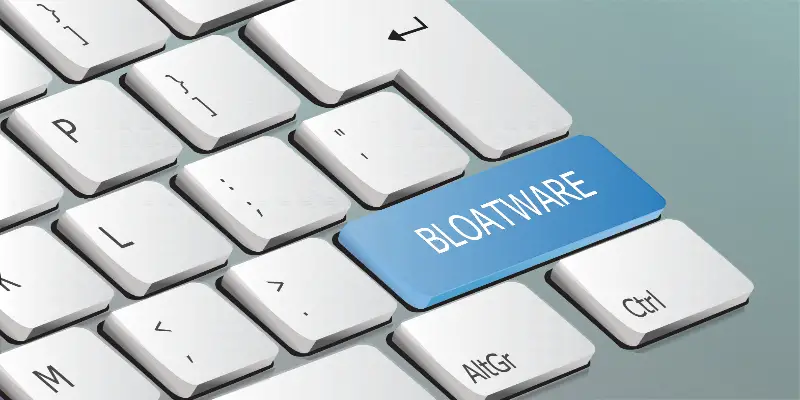Disclaimer: This post may contain affiliate links, meaning we get a small commission if you make a purchase through our links, at no cost to you. For more information, please visit our Disclaimer Page.
Most if not all windows computers come with preinstalled software. It is good of Microsoft to be that mindful. However, we often find ourselves not in need of this software because we have other ideas. Bloatware is a set of software that is preinstalled on our computers, but we don’t need them. This brings up the question, does windows 10 have bloatware?
Windows 10 is preinstalled with its fair share of bloatware. The list of this unnecessary software is quite long. The worst part of it is the third-party apps that Microsoft has included in Windows. However, it is worth noting that the most in the list are the software developed by Microsoft.

The list of this bloatware is almost endless considering that it includes third-party software. This can be quite frustrating especially when you absolutely have no use of any pre-installed software. Microsoft definitely needs to up its game. It should reprogram their windows by adding the basic software.
Doing this will give the Windows computers excellent performance. Everybody will be happy because they are not riddled with the infamous bloatware. Being invaded by unwanted startup apps as soon as you flip your new Window open isn’t the ideal experience you wanted.
Keep scrolling down the page to learn more and find out how you can troubleshoot this problem and others.
Table of Contents
Does the Operating System Come with Bloatware?
The operating system comes with bloatware added on top of it. The software bundles in your operating system are not only of little use to you, but they also weigh down the smooth performance of your Windows. In short, virtually every computer is preinstalled with this nuisance software.
One of the inclusive bloatware in your operating system is the music app. There is also a video editing app, security suites among others. But this is not to say that all software that comes with your Windows computer is useless. Some are legitimately useful, and you will be grateful that they are preinstalled.
What Does Bloatware Do to Your Windows?
Bloatware can be a downright threat to your machine. Most times, it simply plays around being bothersome but do not take that lightly. It could be a ticking time bomb for your Windows computer. Here’s a sneak peek at the harm it can do to your machine.
1. Cause Performance Issues
If your Windows is acting up, the first culprit you should suspect is bloatware. Especially if your machine is painfully slow when booting. You may also notice that it takes its sweet time to open files when you click on them. Another telltale sign is if your battery is always nosediving to zero from being full.
Bloatware will always clog your computer’s memory. This is because this software design is below the standard and it affects your device performance. Regardless of the brand, these programs are built-in less-than-stellar code.
2. Can Be Intrusive
Have you ever gone online and boom! You are pummeled by ads? Adware and toolbars are solely responsible for that. Now you have your culprits, you no longer have to get migraines when you are redirected to unintended sites.
Bloatware will always install everything unwanted on your Windows. They even install extra toolbars on your search engines. Perhaps that answers why you are redirected most of the time you are using your browser. Even though they do very little in this scenario, they can interrupt and bring everything to a standstill.
3. Pose a Risk to Your Digital Security and Privacy
Theft! We cringe at the thought of that. Especially online theft. It is creepy to imagine someone remotely accessing your financial information and getting away with your life savings! They can steal your banking and credit card information and before you can say, Jack Robinson, your account balance is at zero.
Hackers are the main suspects when it comes to such kinds of theft. But they cannot do it alone without innocent assistance by bloatware. They may string you along to the dark web. If they are not done with you, they can fraudulently and indecently use your credit bills. With your name on it.
4. Can Cause Your Device to Crash
Have you ever been in the middle of a very important task and boom! Does everything come to a standstill? That moment your Windows goes blank without a warning? That is what I am talking about. Some of the bloatware can crash your device.
Sometimes, the program might appear to hang. This will force you to reboot your Windows and by the time you get back to where you left, you will have lost important data. Just to be on the safe side of things, some of this bloatware is not worth it, and you can easily remove them.

Where Can You Find Bloatware in Windows 10?
Finding and identifying bloatware in your Windows is very easy. They are mostly on the desktop and you can bump into some when you run through your control panel. Any application that you did not install in your Windows system is candidate bloatware. However, if you need thorough screening, professional IT guys can do that for you. They use a tool that shows installed apps.
What Bloatware Comes with Windows 10?
There can only be so many of these bloatware apps in your Windows 10. The most common ones are third-party apps. Other bloatware is pre-installed by Microsoft. The most unsettling issue about most bloatware is that they are often piggyback on legit programs. This makes it hard for them to be detected.
Here are unnecessary apps you should consider uninstalling from your Windows;
1. QuickTime
This software is found mostly in Apple. This video player is a current program that is preinstalled and might not be of any use to you. The software had been found to have some critical vulnerabilities. Since this app has been certified as unsafe for your Windows, it is easy to remove. Especially since no active software relies on it for performance.
2. CCleaner
This was a reliable software in the days gone by. But since it was acquired by Avast, its credibility was nosedived. Some of the issues that compromised its reputation includes; Unpermitted forced updates. Other grievances include enabled data collection. Especially after the Windows restarts. The software could also spread malware unaware thus becoming a major concern.
The software now claims to have cleaned up and put its acts together. But it has been found to be still wanting in so many ways. If you need to deep clean your Windows device, there are other safe suitable tools to opt for. Therefore, don’t be so depressed about bidding CCleaner adios.
3. Useless PC Cleaners
This is one of those software you install by accident. It poses between being useless and outright harmful to your Windows device. Most of this software that claims to deep clean your system can never improve your machine performance whatsoever.
Some of the bad PC Cleaners include but are not limited to; MyCleanPC and PC Optimizer Pro. If you see any of the two or other unimpressive PC cleaners, you better uninstall and remove them from your device altogether.
4. uTorrent
Once upon a time, uTorrent was the gold standard for movie and series browsers. Sadly, this torrenting software has degenerated over the years. This and other host issues have put the software in the red spot. It has lost both its reputation and credibility among its users.
The popping ads are so much on this software it could give you migraines. Especially if you are that person who wants programs to run seamlessly. It also comes with these offers for other software. The height of it all was in 2015 when the software went behind its users and bundled in cryptocurrency mining.
5. Adobe Flash Player and Shockwave Player
Adobe Flash Player has been removed in all modern browsers. In fact, it is no longer supported, therefore, it cannot update anymore. This is a good thing because you no longer have to be wary of any threats from this software.
On the other hand, its other version Shockwave Player met its infamous end in 2019. It is no longer available for download. These two relics have become dormant and out of time. They reaped a bounty in the glorious day. You can uninstall them since it is of no use having them in your control panel consuming your valuable space.
6. Java
This media runtime was once popular back in the day. But like all the others that came before it, it has been reduced to a mere relic. Just a handful of websites still finds it useful, but the rest of the world has moved on to other updated progressive software.
Java came in two; for the desktop and plugin for the browser. This software is no longer supported by the major browsers. This includes Chrome and Firefox. On the flip side of this issue, it makes the software less of a security threat. If you have no use of it, you can safely uninstall the Java software from your device.
7. Microsoft Silverlight
This software is more like Adobe Flash. It enables the media content in your Windows device. It used to be one of the compulsory accessories in most websites once upon a time. However, this software has degenerated into uselessness. Less than 0.03% of the population websites still use this software.
In fact, this software is not compatible at all with modern browsers. The degeneration came crashing at alarming speed when both Chrome and Firefox stopped supporting it. With the Internet Explorer being its sole support, Microsoft Silverlight has been reduced to being like a one-legged stool.
8. Toolbars and Junk Browser Extensions
These are some of those software you won’t think twice before clicking the uninstall button. Yes, they are that much useless and occupy a good space in your Windows computer. Browser Extensions are considered mere junks and there are no consequences in uninstalling them.
Gone are the glorious days for the toolbars too. Although there are still spammy extensions from them, we can all be grateful to the popular browser for doing away with them. Some of them in the world include; Bing Bar, Google Toolbar, Ask Toolbar, etc… If you are cleaning your Windows Computer, these are the wild oats you should do away with.
9. Coupon Printer
This printer was ideally designed to enable user access to deals from Coupons.com. The first mistake that was made when including this software in your Windows was by bundling it with other bloatware. That is synonymous with throwing your fresh meat in the trash can. It automatically becomes trash.
However, if you are a diehard of this software, this is a big opportunity to access its discounts. However, for those who have no idea of what this Coupon Printer is all about, you can uninstall it since you will not need to put it to useful use. There are so many coupon sites that will not require you to install anything before access.
10. Manufacturer Bloatware
Most computers come with manufacturer bloatware. That is of course unless you are using a premium device. But for the most popular laptop brands like HP, Lenovo, among others, there is no escaping this.
All these manufacturer bloatware will never improve your device performance. All they do is duplicate window utilities and create unnecessary junk. However, when uninstalling, there are those considered useful therefore you should be careful. It is always a good idea to check the overview of a certain program before uninstalling it.
11. Windows 10 Bloatware
Microsoft is the main culprit when it comes to uninstalling some unnecessary software on new devices. That is beside the manufacturer’s bloatware. You can imagine the headache waiting for you in the Store apps! This is not to say they require elaborate exorcism when uninstalling them. Just that there is no need to put them there in the first place.
But as the saying goes, another man’s poison is his neighbor’s food. Perhaps some of this software is useful to you in some ways we on this other side cannot see. If that is the case, carefully browse through your preinstalled apps and carefully select what to get rid of.
12. WinRAR
The initial idea of this software as a compression tool was excellent. However, its underperformance and lack of progress overrode everything. It has been trashed in the relic software garbage can because of its license. What raises the eyebrow when it comes to this software is its inability to lock you out if you don’t pay after the free trial.
Since there are other simple tools with free access, there is actually no need of stringing WinRAR along. Just let it go and try other more up-to-date software. But even if the push comes to a shove, never ever put your money on this app.

How Can You Remove Bloatware from Windows 10?
If you have come this far in reading this article, it means that you have identified some bloatware in your Windows device you want to get rid of. That is a good step to take for your device. All windows already have an uninstaller on the start menu ready to perform the task for you.
1. Open the Start Menu and type Windows Security. Click search.
2. Navigate to Device performance & health page
3. Below the Fresh start, there is the Additional Info link. Click on it.
4. There is a Get Started prompt. Click on it. Accept the UAC prompt and proceed.
5. Fresh start UI will pop on your screen and prompt you with Next or Cancel. Click Next.
6. A list of bloatware apps in your Windows 10 will come up.
7. Carefully go through the list. When you are satisfied with it, click next.
8. Click on Start. This will begin the reinstallation task.
While it sounds like an easy task to perform, you must learn a few ropes before removing your bloatware. There could be some applications in the list that are of good use to you and other users. That is where scrutinizing the bloatware list before proceeding comes in.
It is also worth noting that you might not be able to uninstall the third-party applications in your Windows. This is because they are available in the Microsoft store. As for the rest of the bloatware, they are easy to reinstall if and when the need arises.
How Do You Prevent Bloatware from Your Windows?
You can prevent bloatware from your Windows by following a few simple procedures. However, you should note that what is bloatware to me might be useful to you. It all depends on what you use your device for. Without any further ado, read below;
1. Purchase Bloatware Free Devices
This might not be the viable option you are looking for. Getting a bloatware-free device is like finding an oasis in a desert. Such devices are minimal, but they are as rare as the blue roses. Because of these facts, they can be extremely expensive.
2. Be Careful When Downloading Software
We mentioned earlier in the article that most of this bloatware is piggyback on the downloaded software. Especially the freeware, nothing is truly free in this world. For this reason, you have to scrutinize every free software for any hidden agenda and piggyback bloatware before downloading.
3. Download a Universal Cybersecurity Program
You have to be a vigilante for your Windows computer lest you wake up to your credit cards and names used in the dark web. It is that serious and you have to set impenetrable firewalls. There are many effective and reliable cybersecurity programs. Purchase a solution that will work across all your devices like Clario.
4. Download Direct from the Provider
Never ever use a third party or an agent when downloading software. No matter how cheap it seems. In fact, you should have already learned that cheap is expensive. Go directly to the source to beat the bloatware from riding into your devices incognito. When it comes to matters of cybersecurity, you don’t want to take even the slightest chances.

Conclusion
Not every bloatware is an enemy as they have been painted. There are those you will find to be extremely useful to you. Take advantage of them. What you should be wary of are mostly those ones that steal their way into your device.
Those are the culprits that can give you and your device irreparable damages. If you are not conversant with bloatware, find a tech-savvy professional to help you download software and to screen and uninstall the preinstalled bloatware.
